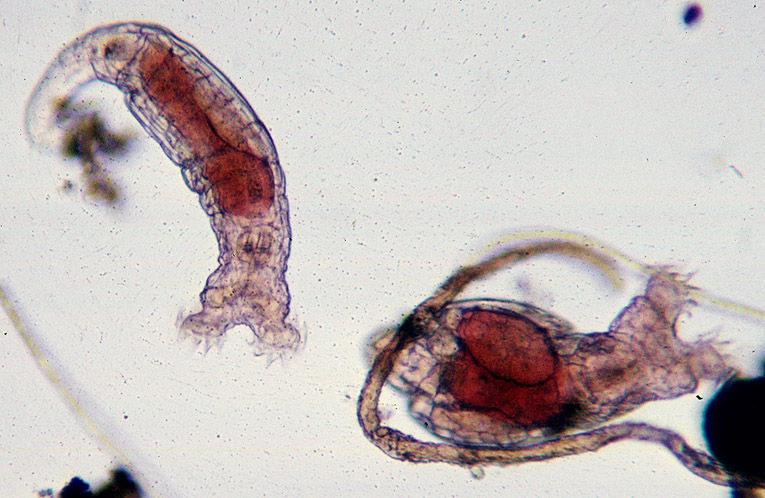
PROTOSTOMIA
Gnathifera
[© Malcolm Storey]
Chapter Outline
- Description of Protostomia
- Classification of Protostomia
- Lophotrochozoa
- Annelida
- Mollusca
- Gnathifera
- Ecdysozoa
- Panarthropoda

Links to external sites will appear in pop-up windows.
Gnathifera is the second subgroup of Spiralia. The phyla in bold are the focus of this page.
- Protostomia
- Spiralia
- Lophotrochozoa (28-III)
- Mesozoa
- Dicyemida - Rhombozoans
- Orthonectida - Orthonectids
- Platyhelminthes - Flatworms
- Nemertea - Ribbon Worms
- Annelida - Segmented Worms (28-IV)
- Phoronida - Horseshoe Worms
- Brachiopoda - Lampshells
- Mollusca - Molluscs (28-V)
- Bryozoa - Bryozoans
- Entoprocta - Entoprocts
- Cycliophora - Symbion pandora
- Gastrotricha - Gastrotrichs
- Acanthocephala - Thorny-Headed Worms
- Mesozoa
- Gnathifera (28-VI)
- Rotifera - Rotifers
- Gnathostomulida
- Micrognathozoa
- Chaetognatha - Arrow Worms
- Lophotrochozoa (28-III)
- Ecdysozoa (28-VII)
- Nematoda - Roundworms
- Nematomorpha - Horsehair Worms
- Scalidophora
- Kinorhyncha - Spiny-Headed Worms
- Loricifera - Loriciferans
- Priapulida - Priapulid Worms
- Panarthropoda (28-VIII)
- Tardigrada - Tardigrades (Water Bears)
- Onychophora - Velvet Worms
- Arthropoda (Ch. 29) >>> (Arthropods)
- Spiralia
| ROTIFERA |
"The discovery of rotifers or "wheel animalcules" dates back nearly three centuries to their first description in 1703 by Leeuwenhoek. They are rather complex, multicellular animals with a size range from roughly 40 microns to over 2,000 microns, so many of them are smaller than the larger members of the protozoa. An excellent reason for studying rotifers is that they are found in such a wide variety of environments, so that if you poke around a bit you're almost certain to have an encounter of the rotifer kind. They are in virtually every lake and stream, every pond, on bits of moss in moist forest, in the tropics and even in icy arctic terrains. A virtually guaranteed place to find some is in sphagnum moss at the edge of a pond or lake. There are marine rotifers, but the vast majority occur in fresh water." - Richard L. Howey
As of 2024, 90 species of Rotifera have been observed in iNaturalist in the US and 183 throughout the world.
| Resources: |
| GNATHOSTOMULIDA |
This is the phylum of Jaw Worms. As of 2024, no observations of Gnathostomulida have been made in iNaturalist throughout the world.
| Resources: |
| MICROGNATHOZOA |
The class Micrognathozoa contains a single species, Limnognathia maerski. As of 2024, the class has not been assigned to a phylum or given its own. Limnognathia maerski has not been observed in iNaturalist.
- Limnognathia maerski
Resources:
|
| CHAETOGNATHA |
This is the phylum of Arrow Worms. Formerly, this phylum was placed in Deuterostomia. Now, after more genetic analysis, they are placed in Protostomia as a member of Spiralia and Gnathifera. They are an example of how Protostomia is not strictly defined by how the embryo develops but by genetics and evolutionary relationships.
As of 2024, only one species of Chaetognatha has been observed in iNaturalist in the US and two species throughout the world.
Resources:
|
| [ Previous Page ] | [ Next Page ] |